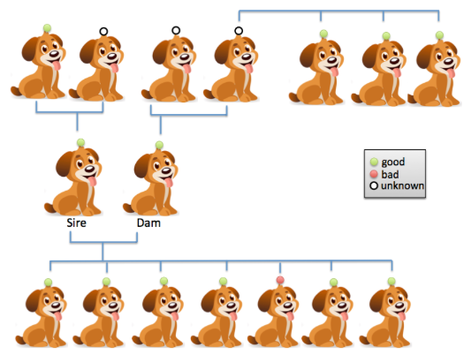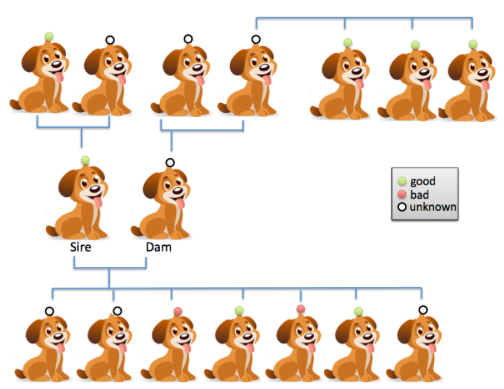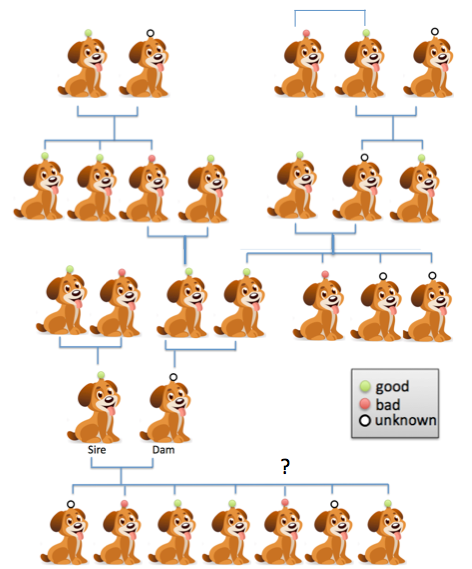The heritability of a trait is specific to a particular population measured at a particular time. A different population could have a different heritability for a particular trait, and even the same population measured at different times can have different heritability. A trait can have a high heritability in a population of animals raised and measured under the same identical conditions (i.e., genes account for most of the variation in the trait), while the same trait can have low heritability in animals raised under different conditions (i.e., differences in environment account for a lot of the variation in the trait).
We don't know what genes affect the risk of hip dysplasia. But a dog will share some of its genes with relatives - parents, siblings, and offspring. We can learn more about the genes in a dog by knowing about the hip evaluations of closely related dogs. Let's look at some examples.
If the pedigree looked like the one below, it would be a bit harder to decide. There is a sibling with bad hips, and there are litter mates with no information. (Maybe bad scores weren't submitted???) There's no info for the dam, and missing information in earlier relatives. Did two pups in this litter get genes that predisposed them to hip dysplasia, or did these two pups love to push each other off the front porch when they were little? Should you breed this dog? What would you do?
Unfortunately, this next pedigree is probably more like what the average breeder will have to deal with. Bad hips, missing data, no patterns, and it's anybody's guess if all you have is this pedigree information to work with. What would you do with this one???
What you need for this problem is a statistical technique called "estimated breeding values" (EBV). This is a way of mathematically predicting the "quality" of the genes in a dog for a particular trait. You can determine the EBV for a particular trait from pedigree information, and some kennel clubs are now providing EBVs for hips and elbows to breeders.
However, with high resolution genotyping we can now determine genomic EBVs directly from DNA (gEBVs). Using DNA is especially powerful because we don't even need to know the relationships among the dogs we have data for. The software evaluates the DNA for each dog, accounts for whether they are affected or normal for the trait, and spits out a number that reflects the breeding value for a particular dog.
Because all the math is done behind the scenes, there are no privacy issues with data. A dog simply has a gEBV based on the information available for related dogs, without the breeders needing to know the specifics of that information. There is no need for secrecy, no fears of getting hung out to dry on Facebook.
If you think you can get enough participation to set this up for your breed, please let us know and we will work with you to get it set up.
You can read more about genomic selection here -
Boichard et al 2016. Genomic selection in domestic animals: principles, applications and perspectives. (Open access)
ICB's online courses
*******************
Join our Facebook Group
ICB Breeding for the Future
...the science of dog breeding
*******************
Visit our Facebook Page
ICB Institute of Canine Biology
...the latest canine news and research




